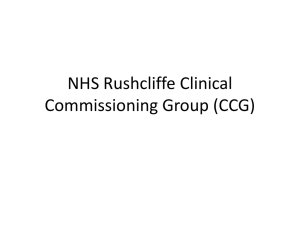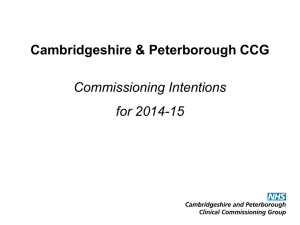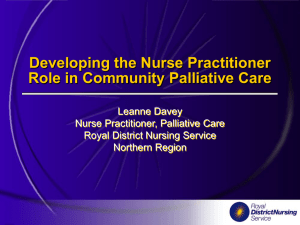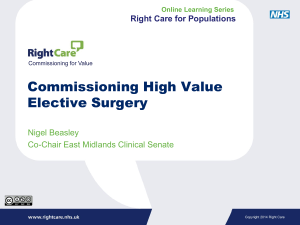Commissioning Intentions Programme Boards
advertisement
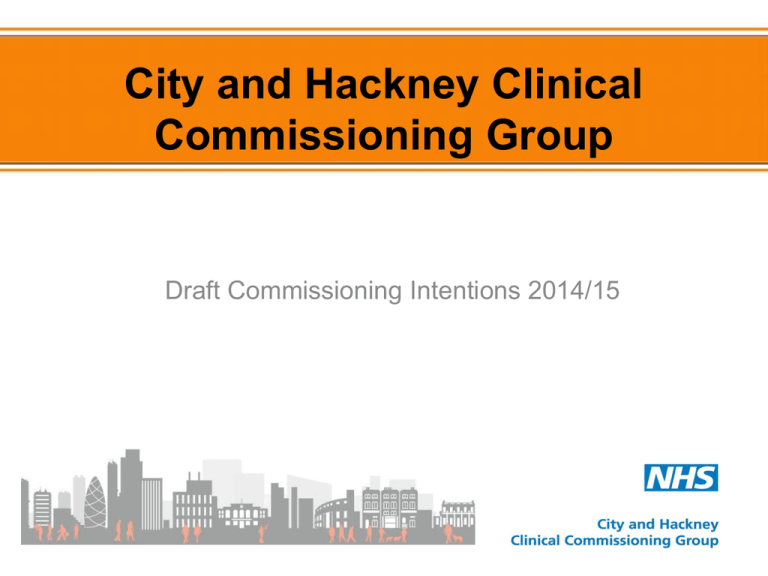
City and Hackney Clinical Commissioning Group Draft Commissioning Intentions 2014/15 Maternity Programme Board Programme Board Objectives • • • • • 3 Ensure our maternity services are affordable, of high quality and improve patient experience Increase the numbers of women who book early Improve the quality of the community midwifery Early identification and provision co-ordinated care for vulnerable and at risk women Ensuring user views drive the service model and improve quality Commissioning Intentions Ensure our maternity services are affordable, of high quality and improve patient experience •On-going review and monitoring of Homerton staffing levels; •Roll out of friends and family. •On-going review and monitoring of the levels of care offered to pregnant women Improving the care of socially vulnerable women: •Improving the services offered to vulnerable women •Agreeing the enhanced offer for vulnerable women •Roll out joint antenatal visits, midwifes and health visitors, for vulnerable women. Review of community midwifery: •Improved patient experience; •Ensuring low risk births receive their care in the community rather than in a hospital setting; •Ensuring maternity services are provided in high quality, patient friendly compliant sites; •Improved access to community provision; •Improved communication between GPs and midwifes. Review of antenatal classes •Review of the full spectrum of Parentcraft provision to see where improvements can be made •Input from the Maternity Services Liaison Committee parent reps •Review of settings and times of classes to increase accessibility •Training for midwifes Urgent Care Programme Board Commissioning Intentions Accident and Emergency (A&E) performance • Review of senior staff (decision makers) presence in A&E and compare against other London A&Es Frequent attenders group • To develop improved relationships with our practices, providing data and improved collaboration with other teams; Improved winter planning • Preparation and provision of additional funds to cope with recognised capacity challenges. Observational Medical Unit (OMU) and associated pathways • New pricing to be agreed to avoid duplication of costs; • Increased utilisation and encourage direct referrals from GPs; • Additional pathway development and implementation – Cellulitis is ready for implementation, Chest pain, Tonsillitis/Quinsy and sudden onset headache are under development. Primary Urgent Care Centre (PUCC) • Development of new service specification taking into account changing needs and the local environment. Commissioning Intentions Out of Hours (OOH) •Embed new provider (City and Hackney Urgent Healthcare Social Enterprise (CHUHSE) into the system; •Strategic marketing of service; •Review likely implementation of additional sites to deliver base services closer to City and the rest of Hackney; •Improved collaboration with local providers, delivering integration where possible. Access in primary care •Increase access and support for same day urgent appointments for practices; •Development of the duty doctor responsibilities and activities; •Increased interaction with Trust A&E and OMU regarding admission and discharge; •Increased capacity for patient visits referred via community services; •Extension of practice hours; •To consider evening and weekend coverage; •To consider individual and collaborative working for practice provision. London Ambulance Service (LAS) •Collaborative review and assessment of existing pathways and the current impact in order to agree necessary changes; •Development of GP support to LAS paramedics in a car service. Pilot to be developed for January to provide support to emergency calls where GP intervention may help avoid conveyance and increased interaction with patients GP and community services. 2014 to hospital Planned Care Programme Board Programme Board Objectives City and Hackney CCG aims to: • Improve the equality of healthcare for our registered patients • Ensure our health care system is affordable, of high quality and improves patient experience • Work with our partners to reduce health inequalities and improve outcomes The Planned Care Board is responsible for commissioning services from hospitals that are arranged by your GP – for example outpatient appointments, planned operations as a day patient or inpatient. Our approach: • Agreed pathways for patients with GPs and hospital doctors working together • Providing training to keep GPs informed • Hospital consultants providing support and advice • Services in the community 9 Commissioning Intentions Commissioning an integrated multidisciplinary community based pain management service • Educating and supporting patients to improve quality of life whilst continuing to live with persistent pain. • Reduced uptake of interventional therapies (injections), promoting a psychosocial approach • An increase in self-management strategies and tools • Increased peer support for service users with persistent pain Total Knee Replacement Pathway • Improved health gain for people who have a Total Knee Replacement procedure • A simplified pathway reducing number of ‘steps’ in the process • Shared Decision Making with patients from all clinicians involved in the new pathway Ophthalmology • Working with Optometrists to provide more testing for glaucoma in the community and to increase numbers of people referred for a cataract operation direct from the optometrist after being supported to make an informed decision about the procedure 1 0 Commissioning Intentions Dressings care •Dressings care will be provided by the right person in the right place through a coordinated service model. •Commissioning specialist dressings care for venous leg ulcers from community nursing service and commissioning for post-operative and ‘other’ wound care from a community provider(s) Diagnostics •Re-commissioning diagnostic tests directly accessed by GPs •Increasing direct access booking for Colonoscopy as part of the implementation of Cancer Best Practice Pathways Community Health Services •Review of current service specifications for ‘Locomotor’ (physiotherapy) Foot Health, Dermatology GPSI and Community Gynaecology services Cancer - Early diagnosis •Working with primary care to improve early detection and treatment of cancer, supported by the Planned Care Board cancer lead in partnership with Macmillan. 1 1 Children’s Services Programme Board Programme Board Objectives • • • • • • • 1 3 Improve the equality of healthcare for our registered patients Improving the health and wellbeing of vulnerable children and families in the longer term Improve working arrangements between practices and community practitioners; To improve the management of long term conditions including asthma, diabetes & epilepsy Ensuring child mental health is a higher priority and that assessment of a child’s mental wellbeing becomes routine across primary care Ensure we are commissioning child friendly services Safeguarding children and young people Commissioning Intentions Improving the management of LTCs in children: •Standardised care plans for children with a long term condition •Annual reviews for all children with a long term condition •GP Practices following up children & families who frequently attend A&E. •Patient education programmes to help children and families manage their long term condition Early identification and enhanced support for vulnerable children and families: •Early identification of vulnerable children and families and enable practitioners to recognise, assess, plan and provide for children as well as parents who need extra support in bringing up their children. •To ensure more pro-active care to address inequalities for those families who may not seek help. •GP Practices to follow up children & families who frequently attend A&E. Improving children’s mental wellbeing •Every family which completes a treatment with CAMHS/First Steps to be offered a follow up appointment in primary care within 3 months of discharge •Every child who presents with self-harm/OD at A&E to be proactively followed up 1 4 Commissioning Intentions Delivering child friendly services •GP Practices will be required to develop policies that ensure their services are accessible and child friendly following a Department of Health Framework. •Developing child friendly leaflets •Ensure practices have knowledge of the range children’s services available locally and how to refer •Ensure the service provision, environment and atmosphere are young people friendly Implementing the changes in special education needs (SEN) code of practice: •Rolling out personal budgets for children with complex health needs; •Working with the Local Authority and Education to roll out joint education, health and care plans for children with special educational needs and disabilities. 1 5 Long Term Conditions Programme Board Programme Board Objectives • • • • • Improve the equality of healthcare for our registered patients Ensure our health care system is affordable, of high quality and improves patient experience Work with our partners to reduce health inequalities and improve outcomes Develop integrated out of hospital services to mitigate the increasing cost of hospital based unscheduled care Reduce the early death rates from cardiovascular and respiratory disease Commissioning Intentions Invest in an expanded integrated care programme •GPs proactively identifying people who would benefit from care planning, based on their risk of being admitted to hospital •Multi-disciplinary care planning, including comprehensive geriatric assessment, regular review of care plans and help for patients from “care coordinators” to manage their care plans •Pro-active home visiting for housebound patients who have a care plan Additional investment in primary care to better identify and manage cardiovascular and respiratory disease, and other leading causes of illness and death in City and Hackney •Building on work to date which has meant that C&H GPs now deliver some of the highest standards of care in London •Extra focus on chronic kidney disease •Making better use of existing data and systems to identify new cases •Extra support for patient on diagnosis with extra long nurse appointments Invest in a new fast track service to diagnose and treat people with atrial fibrillation •Atrial fibrillation is a leading cause of stroke 1 8 Primary Care Quality Board Programme Board Objectives– shared with LTC board • • • • • Improve the equality of healthcare for our registered patients Ensure our health care system is affordable, of high quality and improves patient experience Work with our partners to reduce health inequalities and improve outcomes Develop integrated out of hospital services to mitigate the increasing cost of hospital based unscheduled care Reduce the early death rates from cardiovascular and respiratory disease Commissioning Intentions Educational support to practices to deliver our plans for long term conditions •Education and training re cardiovascular disease, respiratory disease, diabetes, hypertension, chronic kidney disease, all specifically tailored to meet the needs of GP, practices nurses, health care assistants and other members of the practice team •Training in care planning to support integrated care with protected learning time to share good practice across City and Hackney Helping practices improve quality through intra-practice working •Enable practices to find the time to work together to share what works well, e.g., appointment systems, or to provide services for patients from neighbouring practices in order to improve equity of access to additional services Additional support for those practices who need it the most •Practices who have been identified by NHS England (who commission general practice) as outliers on measures of performance, e.g., GP Outcome Standards – practical support to these practices on reviewing systems and procedures 2 1 Mental Health Programme Board Mental Health Need Children/adolescents • 1 in 10 children & young people aged 5 - 16 have a diagnosable mental health disorder - around 3 in every class • Only 25% access effective care • Between 1 in every 12 and 1 in 15 children & young people deliberately self-harm – admissions have increased by 68% in 10 years Adults • 1 in 6 at any time • 50% of all women & 25% of all men are affected by depression at some time in their life • 0.4% adults have a psychotic illness • 5.4% of men & 3.4% of women have a diagnosable personality disorder • Suicide is the greatest cause of male deaths < 35 years • People with schizophrenia are likely to die 15-25 years earlier than others • 30-50% of people with mental health problems are not acknowledged as having a mental health problem at consultation with GP Seniors • 1 in 6 over 65 have depression due to social isolation or physical illhealth • Dementia effects 5% over 65s, 10-20% over 80 • 30% of over 65s in acute trust beds have dementia In physical care services • Up to 50% of people in outpatient clinics have medically unexplained symptoms • 25% of all people with long term physical conditions have depression & die earlier • Alcohol-related injury is approx. 24% of A&E presentations • Stroke patients have anxiety rates of 30-49% up to 12 years post stroke Groups at risk Children and young people Adults Children with parents who have mental health • 4-5 fold increase in onset of mental disorder Children with parents who have substance use problems Children experiencing personal abuse or witnessing parental domestic violence • 2 fold increase of all mental disorder (child abuse) ‘Looked after’ children’ • 5 fold increased risk of mental disorder Children with learning disabilities • 6.5 fold increased risk of mental illness Children excluded from school Teen parents Young offenders • 18 fold increased risk of suicide for men (15-17yrs) Young lesbian, gay, bisexual & transgender people Young Black & minority ethnic groups Children in families living in socioeconomic disadvantage • 3 fold increased risk of mental health problems (children from lowest quintile of household income) Black & minority ethnic groups (7.9% of UK pop) Rates of schizophrenia: • 5.6 times higher in the black Caribbean group • 4.7 times higher in black African group • 2.4 times higher in Asian groups Homeless people • 11.3 fold increased risk in psychosis • 5.5 fold increase alcohol dependence Unemployment • 2.7 fold increase in Common Mental Disorder In debt • 3 fold increase in Common Mental Disorder Adults with a history of violence or abuse Adults with alcohol or substance misuse Offenders & ex-offenders • 20 fold increase in psychosis among prisoners Lesbian, gay, bisexual & transgender adults Travelers, asylum seekers and refugees People with a history of being looked after/adopted People with intellectual disabilities • 3 fold increased risk in schizophrenia Isolated older people Our Target Groups Target Groups Headline Interventions Children and young people - Improved waiting times, access to psychological therapies, DNA and user choice - Improved training for school nursing to identify early prodromal signs - Every child aged 14 upwards thought to meet the EIP criteria will be assessed within 2 days - All children and families social workers, residential staff and foster carers will receive basic mental health training to be repeated every 2 years - Rapid assessment interface and discharge working within A&E and inpatient settings - Wider skills and competencies for community based staff to recognise the signs of psychosis in order to enable swifter referrals - Every patient to have a recovery plan and introduction to benefits and employment support - Reduce waiting times from referral to assessment and treatment - Expand the range of interventions available through IAPT to include IPT and brief interventions - Review of Community Mental Health Teams and the role of EIT, AOT etc - Improved inpatient standards including medication reviews, and a Patients Charter which reflects a minimum set of standards - Improved access to MH support across LTC pathways and within acute care Improved screening and coding - Improved support for patients and carers in the community - Alcohol and substance misuse screening - Improved referral pathways for eating disorders - Integrated psychological therapies improving access at the right time for complex presentations (including Child Tavi?) People new to services People with short term problems People with ongoing problems People withdementia People with complex needs Our plans to improve performance Initiative What will be different/what will be the impact By end of March 2015 Each practice to have access to an SMI management bursary to fund additional training and upskilling of staff. - Increased levels of patients receiving care closer to home - Parity of esteem Integration of voluntary sector reporting systems to support stepped care for common mental health problems - Increased access points to MH services Inclusion of Cluster 18 (mild/moderate dementia) patients in SMI LES - Additional annual health checks for this cohort of patients - Reduced secondary care service costs Development of Single Point of Entry for Psychological Therapies - Develop a primary care oriented CAMHS Tier 1 approach which supports identification and case management within Primary Care (Hackney Healthcheck) - A targeted mental health approach which identifies problems early and supports good emotional health within schools Finalise a CAMHS development curriculum which will actively address concepts of recovery and community involvement within it, identifying people currently missing services - A map local mental health services available to under 18s - A combined CAMHS and First Steps referral form - A family model of CAMHS provision within primary care offering a service to children and families not engaging with CAMHS services Identify who is being missed completely (ie no depression or anxiety diagnosis) - working with public health to look closely at suicide figures, self harm, people on long term sick notes, MUS and repeat analgesics and anxiolytics etc. - Increased numbers of patients receiving psychological support to help manage pain and medically unexplained symptoms - Provide a service for those patients repeatedly presenting in crisis but not then engaging Develop a depression & anxiety element to the SMI LES which will actively address concepts of recovery and community involvement within it, identifying people currently missing services. - Improved voluntary sector interfacing with IAPT and primary care based services for common mental health, increasing the options of support for SMI LES patients. 2 Revised Outcomes Framework across CAMHS services to an 6 Improved care pathways across psychological therapies with Reduced DNA and drop out.. Increase in need being meet moving from 15% to 17% for common MH Increase in concurrent employment support services - All providers delivering high quality care to the same standards across statutory and Our plans to address user concerns Initiative What will be different/what will be the impact By end of March 2015 Discharge Counselling for medication - 100% of patients to receive discharge counselling improving compliance and reducing readmission Social marketing of emotional wellbeing resources - Improved self-care amongst MH patients with a refocus on community and personal assets Recovery planning - All patients to hold a user-defined recovery plan - 100% of patients to be given or offered a printed copy of their care plan Advocacy - All patients to receive an easy to read version of the Care Review process to include information on advocacy. Alcohol - 100% of patients to be asked about their alcohol intake and brief interventions/treatment initiated where relevant Carers - All carers to receive an assessment and signposting to support Crisis - Timely access to crisis which uses inpatient resources effectively and at the right time User voice - Pan borough User Advisory Group to influence and inform commissioning decisions. Employment support - Employment support services coterminus across service provision. This will involve coordinated work with Job Centre Plus. 2 7 Prescribing Programme Board Introduction • Medicines are the most frequent intervention and cost the NHS over £12 Billion in 2011 • If used appropriately, medicines can make significant impact on reducing morbidity, mortality and demand on other health resource • Research has shown that at least 6% of emergency admissions are due to adverse drug reactions and that up to 50% of prescribed medicines are not taken as intended • City & Hackney CCG will spend approximately £27M on medicines in 13/14 - this medicines expenditure is likely to grow annually • Effective management medicines activities will enable City &Hackney CCG to: – secure efficiency and value for money through cost effective prescribing choices – improve patient outcomes – ensure quality of medicines used in commissioned services 2 9 Our plans to improve clinical outcomes Initiative What will be different/what will be the impact By end of March 2015 • Adherence and improvements in Clinical Outcomes • • • • • Adherence - Increase patient engagement http://www.nice.org.uk/CG76 3 0 • Medication review of prioritised patients in key clinical areas Cardiovascular Respiratory Mental Health Improved use of medicines to prevent morbidity and hospital admissions in the prioritised areas Identify through patient groups – gaps in medication reviews/ use reviews Improved provision of information for patients on appropriate ordering of repeat prescriptions By end of March 2016 • • • • • Subject to level of funding make available to each C&H practice, medication review for all prioritised clinical areas Improve adherence & clinical outcomes of patients with cardiovascular, respiratory and mental health Reduce medication waste Increased access to medication related counselling for patients Improving patients awareness and uptake of medication review / Medicines use review schemes Improvements in patients’ knowledge about the medicines that they take Our plans to address members concerns Initiative What will be different/what will be the impact At the June 2013 – CCG Prescribing Forum, practices identified areas of concern - clinical areas to be addressed as follows: By end of March 2015 By end of March 2016 Prioritising clinical outcomes over cost savings Reviewing how we align cost effectiveness of prescribing with clinical outcomes Measuring the impact of medicines related interventions on morbidity and hospitalisations Clarification about recommendations from the Pain Clinic Pain guidelines – development and practice implementation Measuring impact of Pain pathway and prescribing guideline on prescribing and hospital services Review of combined drug inhaler use Respiratory Medication reviews Improved implementation of NICE/BTS guidelines on Asthma and COPD Continuation of Pharmacist support at individual Practice level Each practice to be offered support from dedicated Pharmacists (pending funding) to support quality improvement of prescribing Each practice to be offered support from dedicated Pharmacists (pending funding) to support quality improvement of prescribing 3 1 An overview of the relationship between our future plans and our strategic objectives Area Strategic Objective • Medicines Optimisation Strategy Effective Formulary, prompt implementation of NICE guidance • • • Effective local decision making arrangements Cost effective use of medicines and budget management Continued development of relationship with community pharmacy Advice available for safe handling of medicines provided or commissioned by CCG 3 2 Work with our partners to reduce health inequalities and improve outcomes Reduce the early death rates from cardiovascular and respiratory disease Improve the equality of healthcare for our registered patients Improve the equality of healthcare for our registered patients Activity • Patients supported with medicines taking Safe use of medicines in all settings • • • Robust process for entry of new medicines, safe/effective systems in place for considering individual funding requests Ensure our health care system is affordable, of high quality and improves patient experience • Develop integrated out of hospital services to mitigate the increasing cost of hospital based unscheduled care Expenditure data, future strategic plans, management of payment by results excluded drugs Work with our partners to reduce health inequalities and improve outcomes Effective methods of communication established with community pharmacy Work with our partners to reduce health inequalities and improve outcomes Ensuring access to medicines out of hours, development use and monitoring of patient group directions (PGDs), medications governance and policy • • • NHS constitution and NICE funding direction are met • • Future plans • • • • Respiratory pharmacist to extend medication review pilot which has ↑ QoL, adherence to therapy, ↓ unnecessary prescribing Medication reviews in care homes Use of "NHS Informatics" tool to relate outcomes/ prevalence data to prescribing, use of ScriptSwitch Continued use of sessional pharmacists to identify opportunities for medicines to be optimised within practices Continued management of the eBNF following launch in 2013. This joint project between CHCCG and HUHT will support DoH requirements for Innovation, Health and Wealth. Future NEL wide formulary to improve quality and cost planning Continued collaboration with NEL Medicines Management Network, impact of new drugs being identified Strengthened management of Individual Funding Request process Sessional pharmacists will continue to deliver QIPP plan and generated savings to enable CCG to stay within prescribing allocation and reduced inappropriate prescribing Budget updates and forecasts provided regularly, improved processes in the management of HCD to reduce variation for C&H patients • Future plans to train community pharmacists to provide CVD and respiratory interventions and motivational interviewing for patients on long term medication • Development of audits to encourage reflection on current practice and to support implementation of procedures where deviations from safe and effective practice had been identified Monitoring of Serious Incidents and effective use of PGDs •
